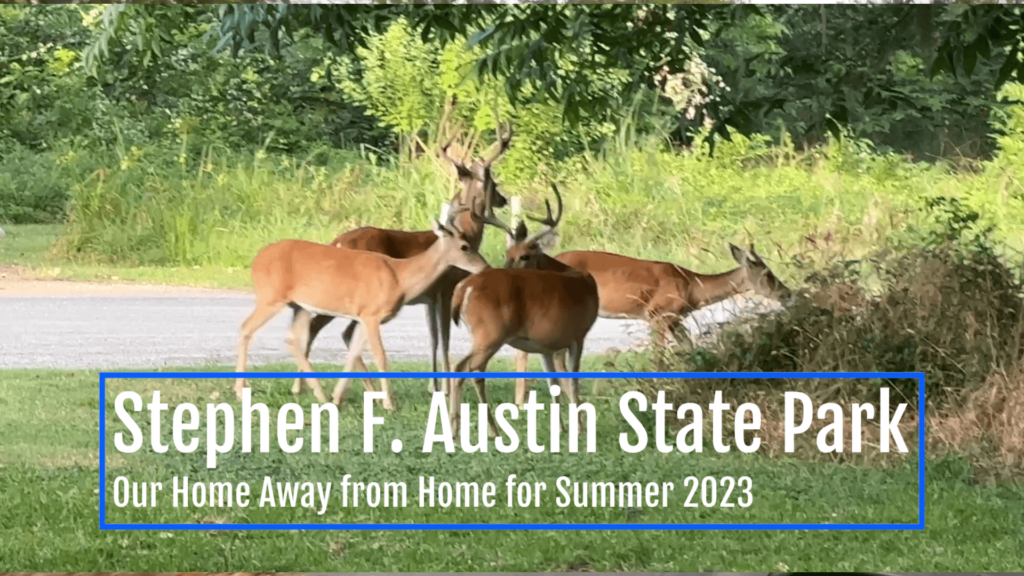Stephen F. Austin State Park
Stephen F. Austin State Park with Wildlife Galore
This video was taken by volunteer Park Host, Jim Munchbach, on August 27, 2023. The wildlife clips were taken over the last few weeks and inserted in today’s Stephen F. Austin State Park Tour B-Roll for The Missional Money Podcast.
🌳 Explore the beauty of nature at Stephen F. Austin State Park! 🦌 Get ready for an adventure filled with wildlife galore as we take you on a virtual tour of this stunning park. 🌿🐿️
In this video, we’ll immerse ourselves in the lush greenery of the park, encounter adorable squirrels and deer, and soak in the tranquil atmosphere. 📸🌄 Whether you’re a nature enthusiast or just looking for a peaceful escape, this park has something for everyone.
🔍 Discover hidden trails that lead to breathtaking vistas and enjoy the harmony of birdsong as you explore. 🦜🚶♀️ Don’t forget your binoculars to spot the diverse bird species that call this park home!
#StephenFAustinStatePark #WildlifeGalore #NatureAdventure 🌲🦉
Join us on this virtual journey and let the serenity of nature captivate your senses. 🎥🍃 Don’t miss out on this opportunity to experience the wonders of Stephen F. Austin State Park from the comfort of your screen. Hit the like button 👍 and subscribe for more nature-filled escapades! 🌅🦢
📌 If you’ve been to this park or have any wildlife encounters to share, let us know in the comments below. 👇 We’d love to hear your stories and tips for making the most of this natural haven.

On the Banks of the Brazos
Stephen F. Austin chose this area as home base for es tab lishing Anglo-American colonies in Texas. Learn more of his story and enjoy a time-out in nature on the banks of the Brazos River. We’re just 50 minutes west of the outskirts of Houston.
Things to Do
Explore our trails, bring a picnic, look for a geocache or wild life, or set up camp. Learn about Texas’ early col o nists at nearby state historic sites. Plan your next reunion at our dining hall or group camp.
Trails
Five miles of hiking and biking trails wander along the river bank under tall hardwood trees and through the up land swamp.
Learn about the plants in the park along the .12-mile Nature Trail. Find out more on our Trails Information page.
Note: We close trails when they are muddy. Contact the park to check on conditions before you visit.
Camping
Choose from full hookup or tent sites. We also have a group camp with water.
If you prefer a roof over your head, reserve a screened shelter or our cabin.
Historic Sites
Visit San Felipe de Austin State His toric Site nearby. Walk around the townsite, head quarters for Stephen F. Austin’s original colony. Visit the museum, which tells stories of the early settlers in Texas.
Volunteer
We need your help! Join or donate to the Friends of Stephen F. Austin State Park. Help with mowing, litter pickup, trail repair and camp hosting. Contact the park office for more information.
Ranger Programs
Check our Events page for upcoming hikes and programs.
Visit our Nature and History pages to learn more about the park. Or down load:
Connect with us on Facebook and Instagram.
Kids
Sign up for our summer camp for kids aged 8 to 11 years old. Call the park for information on the schedule and registration.
Become a Junior Ranger!
-
Borrow an Explorer Pack loaded with tools for exploring the park.
-
Pick up a free Junior Ranger Activity Journal at the park. Complete tasks to earn a badge.
Area Attractions
Nearby cities of Sealy and Bellville have restaurants and shopping.
Stephen F. Austin State Park a Camper’s Perspective
I Fell in Love With Camping at Stephen F. Austin State Park
This peaceful spot near Houston is perfect for families, history buffs, and first-time campers.
January 4, 2023

Stephen F. Austin State Park. Laurence Parent
“I love you guys! Can I sit in the middle?” my four-year-old announced, as she hauled her chair to the campfire. My husband, Ben, cooked hot dogs while our ten-year-old and I huddled close by and snacked on chips. Our conversation turned to fire-building strategy and reminiscing about our previous camping trips. It was a cold, rainy Saturday evening in November, and we’d driven an hour west of our home in Houston to camp overnight at Stephen F. Austin State Park. After refreshing the forecast all morning and double-checking our crowded Google calendar, we decided to go ahead with our plans despite the crummy weather. As any parent of a preschooler knows, “You get what you get.” I’d booked the trip only a few days before, seizing the rare opportunity for a free evening and an available campsite. Snagging a weekend reservation in a Texas state park can be a little like scoring Taylor Swift tickets, but I’d taken advantage of Texas Parks and Wildlife’s Camping This Weekend site to find a last-minute spot. The proximity of Stephen F. Austin was comforting: we could bail if the toddler melted down, and the short drive meant we were spared frequent “Are we there yet?” questions.
It was our second time back to the park, and we all felt more confident than we had during our first visit two years earlier. Neither my husband nor I grew up camping, so the learning curve had been intimidating. On our earliest trips, we struggled to make a campfire big enough to roast our hot dogs, and a raccoon ransacked the packaged food we left outside. Despite these rookie mistakes, a weekend outdoors, with minimal cell phone reception and a blissfully blank itinerary, quieted my mind in a way that previously eluded me. We explored the woods and watched white-tailed deer nose among the cottonwoods. To my surprise, there was a group of Persian families at the campsite across from ours. The joyful scene brought back memories of visiting my dad’s hometown of Shiraz, Iran, where families picnic together in lush gardens. By morning I was smitten with this underrated gem of a park—and with camping. I felt inspired to explore more of Texas’s outdoor splendor with my family.
History buffs will find much to enjoy at Stephen F. Austin State Park, which sits just outside the tiny town of San Felipe. This place was once the Colonial Capital of Texas, founded in 1823 by its namesake. Human habitation in this area has been dated back to at least 7400 BC, with early occupants including the Tonkawa and Karankawa tribes. This pocket of land near the Brazos River served as the epicenter of events leading to the Texas Revolution. The town was evacuated and burned just a month before Texas’s independence from Mexico. While the city never regained its former glory, the impact is lasting, and next to the park sits the excellent, recently revamped San Felipe de Austin State Historic Site, where you can stroll through replicas of the colony’s log cabins and tour a 10,000-square-foot museum. There are also history presentations at the state park every second Saturday.
 San Felipe de Austin State Historic Site.Courtesy of Texas Historical Commission
San Felipe de Austin State Historic Site.Courtesy of Texas Historical Commission
Though the greater Houston area isn’t well-known for its natural beauty, it should be. The park is located in Austin County, which straddles two ecosystems: the post oak savannah and the Gulf Coastal prairie. Near our campsite was the 0.12-mile Nature Trail, brimming with silver placards describing the vegetation found in the park’s diverse forest communities. Ben and I set up our tent in the lingering drizzle while the kids stayed warm and dry in the car. Stephen F. Austin offers a hundred campsites that cover the full array of camping experiences, from full RV hookups to primitive sites, along with screened shelters, a single cabin, and a group site with water. As on our first trip, I opted for a primitive site, which lacks water but makes up for that amenity in proximity to a restroom.
As soon as we squared away our campsite, we headed out on our first hike, a loop we made by piecing together the Ironwood Trail and Pileated Trail. Our makeshift loop was just under two miles, which is usually doable for our four-year-old. Almost immediately we spotted white-tailed deer walking across the private golf course that borders the park. While the four of us gazed in silent rapture, one of the herd paused to stare back at us. The Barred Owl Trail was closed, but our ten-year-old and I detoured along the Sycamore Trail while Ben and our preschooler headed back to the campsite. The ghostly bark of the sycamores towered above us, and the soft path was covered with a carpet of autumnal leaves. The trail was filled with a menagerie of birds, including chubby wrens and brightly feathered cardinals. Northern harriers circled overhead. The current park checklist includes more than ninety avian species, from bluebirds and hummingbirds to vireos, black-bellied whistling ducks, and pileated woodpeckers.
For those seeking some educational guidance, the park is resuming its monthly First Saturday Nature Walks on January 7. All ages are welcome, and the walks typically take about an hour and start at 10 a.m. near the Nature Center. Children age twelve and under get in free, and day passes can be purchased for $5 per adult. (We visit parks so frequently, we’ve purchased the annual park pass for $70.) Parents may also be pleased to learn that the park is resuming its summer day camps in June 2023 for children eight to twelve years old, with registration opening in March 2023.
Before rejoining the Pileated Trail, we accidentally veered off the main path and made our way to a peaceful overlook of the Brazos River, which serves as a boundary to the park to the north and east. This muddy, winding waterway, which snakes 840 miles across Texas to the mouth at the Gulf of Mexico, is the longest river in Texas. According to one legend, Spanish explorer Francisco Vázquez de Coronado was on the precipice of death when Native Americans led him to the water source, which they consequently named Rio de los Brazos de Dios (“river of the arms of God”). Although we didn’t venture to the banks, fishing is encouraged. Shortly after passing a wildlife viewing station, we crossed paths with several white-tailed bucks. Other creatures found in the park’s heavily wooded bottomland include coyotes, bobcats, skunks, raccoons, opossums, and armadillos. The trails here are generally wide and flat, and what they lack in breathtaking vistas, they make up for in quiet opportunities to observe nature. The gentle rustling of tree leaves, the call of birds, the visual curiosity of tropical dwarf palmettos scattered in wooded brush—and occasionally, if you are very lucky, a moment when your introverted and generally reserved oldest child opens up a bit about life.
We arrived back at the campsite to the four-year-old yelling proudly, “We won! We won!” Despite claiming earlier that she could not take one more step, she managed to finish the short hike, encouraging her dad by repeating “We have a good pace” and “Don’t give up until you’re done,” on the last little stretch back to camp. It rained lightly after dinner, and we ate raw s’mores on burnt graham crackers because we’d forgotten our fancy skewers that rotate 360 degrees. This didn’t faze the kids, who are content with any opportunity to eat marshmallows. Overnight, I woke to barred owls hooting their signature “Who cooks for you?” from 2 a.m. to 4 a.m., or so my husband reported with exasperation when I asked if anyone else heard them. Meanwhile, the kids slept like rocks, a small miracle that happens every time we camp.
The weather was gorgeous the next morning, and we rallied for a hike to finish exploring the remainder of the five miles of trails. We parked near the amphitheater and walked along the edges of the Cottonwood Trail, Copperhead Trail, Brazos Bottom Trail, and Opossum Trail to make a manageable 1.74-mile loop. Three of the paths cut across, so the hike could be amended for less-obliging toddler hikers at any moment. This proved useful, as our youngest was not in the mood. While Ben took her across on the Cottonwood Trail, the ten-year-old and I followed the Copperhead Trail. Despite a large sign warning, “Caution: Venomous Snakes Exist in this Park,” we were spared seeing either of the two venomous snakes (copperhead and eastern coral snake) that make their home within the park’s boundaries. Our path meandered past pockets of lush old-growth forests that seemed reminiscent of a fairy tale. My daughter and I emerged to find the other half of our family waiting in much better spirits. We all packed up and headed back to real life, recharged from a little time in the woods.





